Partner Research
The State of Connected TV Advertising
by Stephen Graveman13 min read
In partnership with:

Abstract
- MNTN and Digiday surveyed 123 leading brands and agencies to learn about their experiences with Connected TV and their future plans with the platform.
- From 2018-2021, over 55% of brands and agencies have shifted marketing budgets towards CTV—and most are pulling from linear TV and social media budgets.
- CTV is removing barriers between brand and performance marketing teams, creating a hybrid awareness-performance model that is increasingly part of CTV campaign strategies.
- To better prepare for the campaigns of tomorrow, leading agencies and brands are utilizing key steps to build effective CTV teams.
Introduction
For marketers of every stripe, Connected TV advertising has arrived, and the channel is transforming the ways brand and performance marketing teams approach their roles within the advertising process.
As measurable outcomes and actionable ad formats are now possible in the realm of sight, sound and motion, the technology powering CTV experiences for audiences is closing the delta between long-standing TV marketing approaches—i.e., repetition and brand recognition—and new avenues to revenue and insights.
“You’re combining that very high-impact brand presence associated with linear television—that big-screen TV ad experience from a recall standpoint, from an emotional standpoint—with CTV, merging awareness with all of the benefits of digital,” said Alexa Tierney, senior director of customer success at MNTN. “Now, you’re actually able to do more advanced targeting and specific targeting, and you can actually measure the effectiveness, testing and basing of your actions on actual data that you can track in something close to real time. It’s really the marriage of two worlds.”
To further highlight the changes underway for marketers working with Connected TV, Digiday and MNTN surveyed 123 brands and agencies to learn more about their experiences with CTV over the past year — and to put a lens on what their teams intend to do with the channel in the year to come. The results, found in Digiday’s The State of TV Advertising in the Connected Age report, highlight the responses from some of the world’s leading advertisers and explains what this means for other brands and agencies.
The new research highlights a moment of growth, expansion and transformation. Spend on CTV is surging. Advertisers’ emphasis on the channel is intensifying. Advertisers’ goals for TV in the marketing mix are altering, with the expectation—and delivery—of CTV-powered revenue on top of brand awareness driving a significant shift of advertising dollars. Budget is moving out of linear and even social media, and it’s headed to CTV. Alongside these changes, there are challenges. Questions around data resources, skill sets, fragmentation, new steps and newly needed tactics are in play.
Our survey highlights these factors as well, and case examples of advertisers working to conquer the complexities of an increasingly powerful channel further illustrate the steps and solutions they’re enacting.
Why CTV Has Become an Essential Marketing Channel
For most of the brands and agencies in our survey, CTV’s acceleration as a go-to advertising approach has been underway for some time. More than half of the respondents (55%) said they started shifting their marketing budgets to Connected TV between 2018 and 2021.
The surge, according to a recent Digiday report, became especially evident in the 2020 upfront season. “CTV took from everybody,” said one agency executive (speaking anonymously) in the article. “It took from linear folks. It took from traditional digital partners. That’s where we know the eyeballs are going, and the dollars have to follow that.”
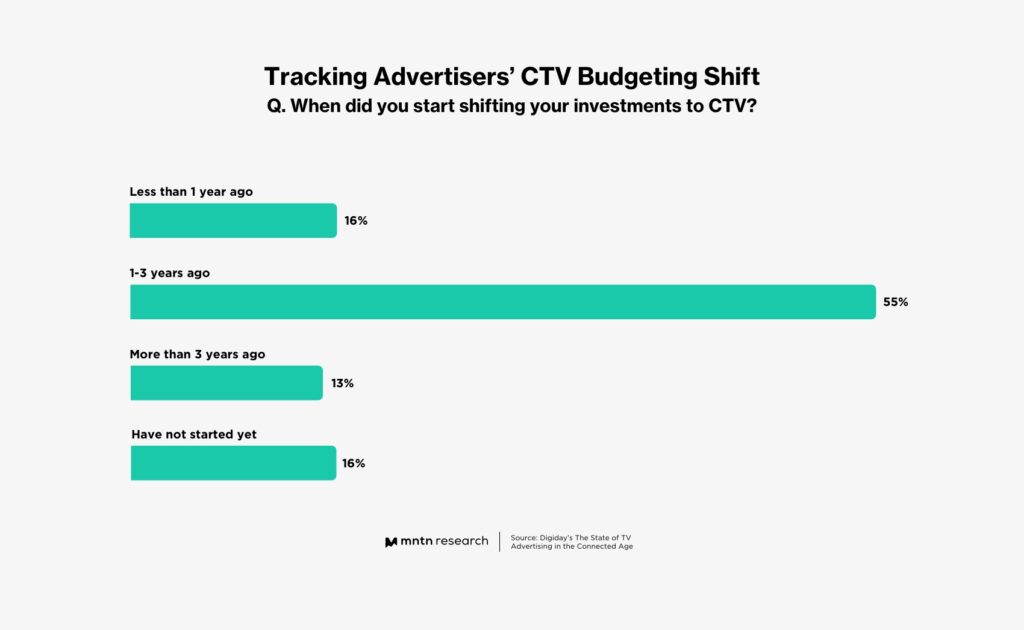
Experts interviewed for this report have watched the channel deepen its roots in the past three years. “If we look at the timeline,” said Tierney at MNTN, “three-ish years ago was the early adopter stage. Whereas now, if I look at the past year, CTV in the marketing mix has become something that’s no longer a question of, ‘Should I run CTV?’, but, ‘How and where am I running CTV, and what am I doing from a strategic point of view with it?’ “It’s more of a mainstay,” said Tierney, “and people know that it’s something they should really be exploring and maximizing for their brand.”
Online home improvement retailer Build with Ferguson integrated CTV as a way to find potential new customers. Scott McConney, performance marketing manager at Build with Ferguson, said the brand adopted the channel in recent years because of its targeting and creative capabilities. “With tactics such as 30-second video ads, CTV gives us the opportunity to explain what our business is and what we do,” said McConney, “as well as what differentiates us from our big box retail and other online retail competitors.”
Survey respondents quantified how much of their marketing budget moved to CTV in 2021 and how much they expected to shift to the channel in 2022. Their responses show incremental increases to Connected TV ad budgets in the 21%–80% range, with a notable uptick of six percentage points among those moving 61%–80% of their marketing dollars to the channel. Overall, more than half (51%) allocate more than 40% of their marketing budget to CTV campaigns.
Where is this movement of marketing allocation occurring? Respondents highlighted two primary sources—linear TV (58%) and social media (41%). Where is this movement of marketing allocation occurring? Respondents highlighted two primary sources—linear TV (58%) and social media (41%).
That CTV is borrowing from linear’s long-standing allocation is hardly surprising. However, given that social media—social commerce and social display, in particular—also saw heightened interest and attention and spend in 2020 and 2021, the move of advertising budgets from that channel to CTV stands out. Reasons may be related to repurposing. As Digiday reported last fall, advertisers combine social video into longer-form edits and deploy them to streaming TV platforms. Marketers moving dollars to CTV is one kind of evidence for a booming advertising channel, but so is CTV’s perceived role in strategic planning. Almost all survey respondents (89%) identified Connected TV as significantly—i.e., moderately to very—important in their omnichannel advertising strategy this past year.
Driving that perception of value to the marketing strategy is CTV’s position in a privacy-forward marketplace. With IP addresses being an essential part of the targeting equation in the Connected TV advertising space, experts say the channel is likely scooping up dollars from budget lines that can’t deliver the same insights in light of data restrictions dependent on other ways to track the customer journey.
How CTV Gets the Message to the Medium
As marketers work to follow their customers in the CTV space, they are turning to a familiar spectrum of data and targeting solutions. A majority rely on first- and third-party data (even as the final moments of the third-party cookie approach). Geolocation and contextual targeting also hold significant positions on the respondents’ shortlists.
Within those categories and approaches, one data type has been prevalent in CTV’s recent past. “The nice thing is at this point, CTV is still very household-based,” said Tierney at MNTN. “So, you know, we’re talking about IP-based targeting, which, knock on wood, is still in a stronghold. And so, I think it’s an opportunity for advertisers to take budget that they’re maybe not able to effectively invest elsewhere, or not as much as in the past, and still have a really effective means of reaching their audience. It hasn’t been affected in the same way yet by recent legislation.”
Marketers, however, are watching recent developments carefully: With iOS 15, for example, users are now able to opt-in to hide their IP address on Safari. The outcome is a fresh mandate for marketers: The value exchange they offer for the customer data they need has never been more critical. That said, CTV advertisers can rest easy regarding IP address scrutiny for the time being.
Concerns around IP addresses are nowhere near the levels for other data that sit at the center of the online privacy debate: third-party cookies and mobile app tracking. One can compare how Apple handled IP address privacy versus its treatment of mobile app data in the recent iOS 14 update. For mobile app data, Apple’s default setting now requires users to take action by asking them to opt-in to share their information.
IP address privacy, on the other hand, requires users to navigate to their settings to opt-out — a small yet significant difference that affects how many users actually hide their information. As with all advertising channels, transparent people-based approaches with contextual alignment are at the center of every initiative in the CTV space. The approach is the only way to continuously and successfully run a marketing campaign that gets its message through the privacy gate and into the consumer’s consented—and welcome—consideration.
CTV is Transforming Brand and Performance Team Expectations
In 2021, the rise of CTV has coincided with a surge of online audiences and a revolution in how performance and actionable engagement have become synonymous with CTV campaigns. “That was a game-changer for us, seeing that we aren’t only driving awareness, but lower-funnel tactics as well,” said Myles Dacio, senior marketing manager at Allergan, in a recent Digiday report. As those elements change how advertising in Connected TV works, the dynamics between performance and brand marketers are evolving. For example, in a recent campaign that MNTN ran with a well-known national rental car brand, the project started with a familiar approach to awareness from the company’s branding agency but soon became a performance moment for all teams.
“In this case, the client was monitoring their Google Analytics account and started noticing that they were getting a tremendous volume of traffic incoming,” said Ali Haeri, vice president of marketing at MNTN, in a recent Digiday article. “And by the way, this traffic was actually converting. “So the campaign was doing exactly what it should have,” he continued. “However, the client was so curious about the uptick that they reached out to us directly … they were fascinated that they were seeing that these TV campaigns that their branding agency was actually running for them were resulting in a lot of great performance for their brand.”
Haeri said that other advertisers have made conversion optimization a priority for their CTV campaigns. Brands have come to realize that they can prompt viewers to visit their website and convert, helping them promote new products or seasonal sales, in addition to raising general brand awareness. This revelation has brought television out of the pure-awareness arena and into a space that is mixed with performance-focused goals. As advertisers work with that kind of convergence, their approaches to outcomes are transforming. In the new survey, respondents said a hybrid awareness-performance model is increasingly part of their CTV campaign strategy.
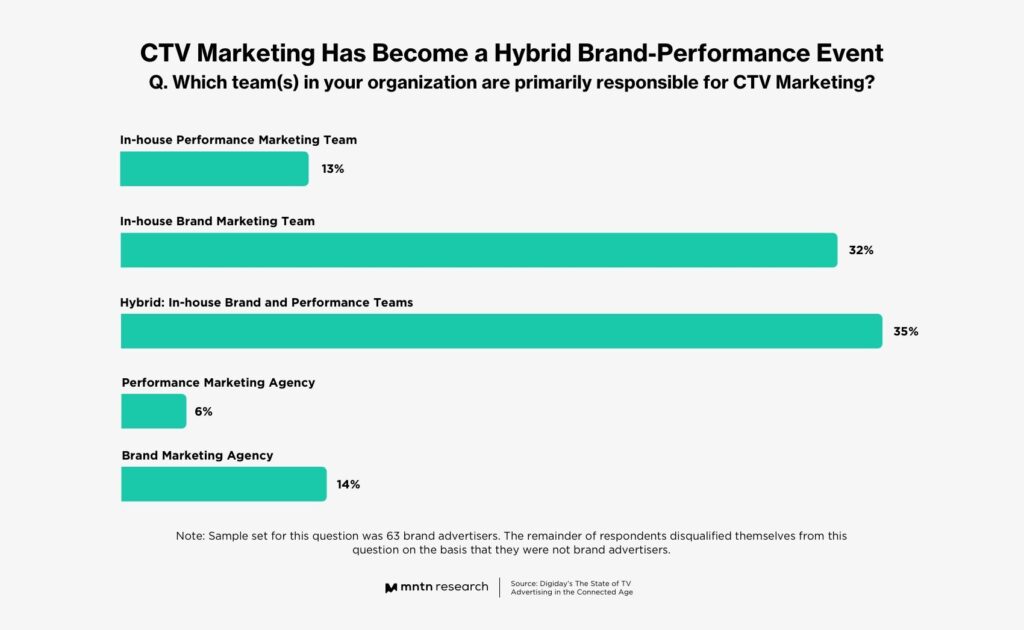
The shift to hybrid is clear. While pure brand-awareness plays for CTV marketing represent a combined 46% of respondents in the survey, just 11 percentage points away is the hybrid brand-performance model at 35%. What counts as success when it comes to the approaches these teams are taking? Essential to know is that while the teams are converging, the KPIs are still somewhat divergent. While the evolution of performance in the CTV space will be televised, the story is still developing regarding KPIs and business impact.
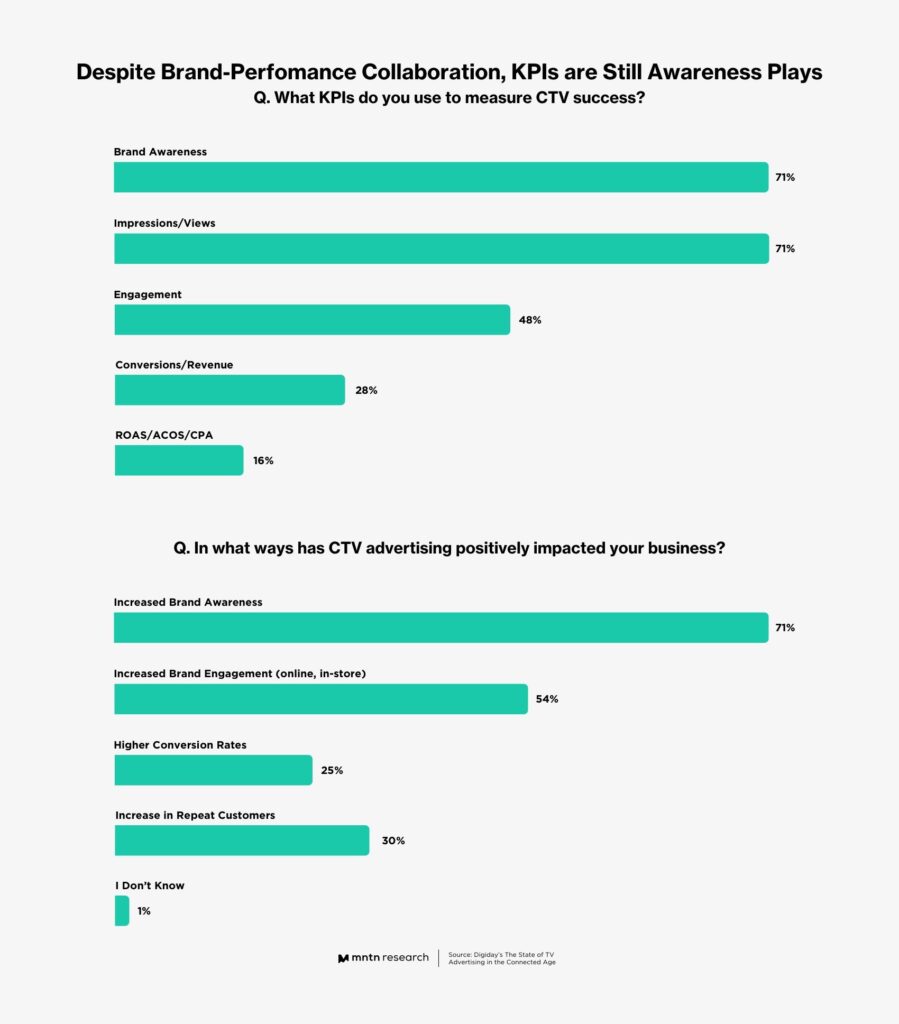
Awareness and impressions still account for three-quarters of the given list, in the case of both questions, and engagement metrics for about one-half in both as well. That being said, returns-based KPIs are tallying at 44% in the first graph, showing a significant percentage of dollar-based outcomes. The combined percentage of conversions/repeat customers in the second graph (55%) illustrates the experience-to-wallet relationship CTV is driving.
Opportunities and Challenges: Putting CTV to Work
Another advantage of CTV is that it gives marketers the ability to test multiple creatives against a specific audience and test what types of campaigns bring value to a business. This testing component helps advertisers gain stronger insights into different aspects of their campaigns; not only can they measure their ad’s effectiveness, but they can also compare how that message lands with one audience versus another. This streamlined testing approach simplifies what once would have taken multiple tools and far more time on a channel like linear TV, and instead condenses it into a task that can be carried out within a CTV ad platform.
Tierney at MNTN said that companies benefit from trialing and iterating different approaches as they adopt or advance their CTV strategies. “Advertisers should have an idea of what their current challenges are, what they want to solve for and how they can measure from testing,” said Tierney. “CTV can help solve a lot of problems and it can be tweaked as priorities change. Advertisers should come with challenges they want to solve for and work with their tech partners to map out how they can set up testing roadmaps to solve it.” Since adopting CTV, our respondents have achieved stronger connections between digital and TV marketing (71%), as well as more engaging creative formats (50%) and precise audience targeting (50%).
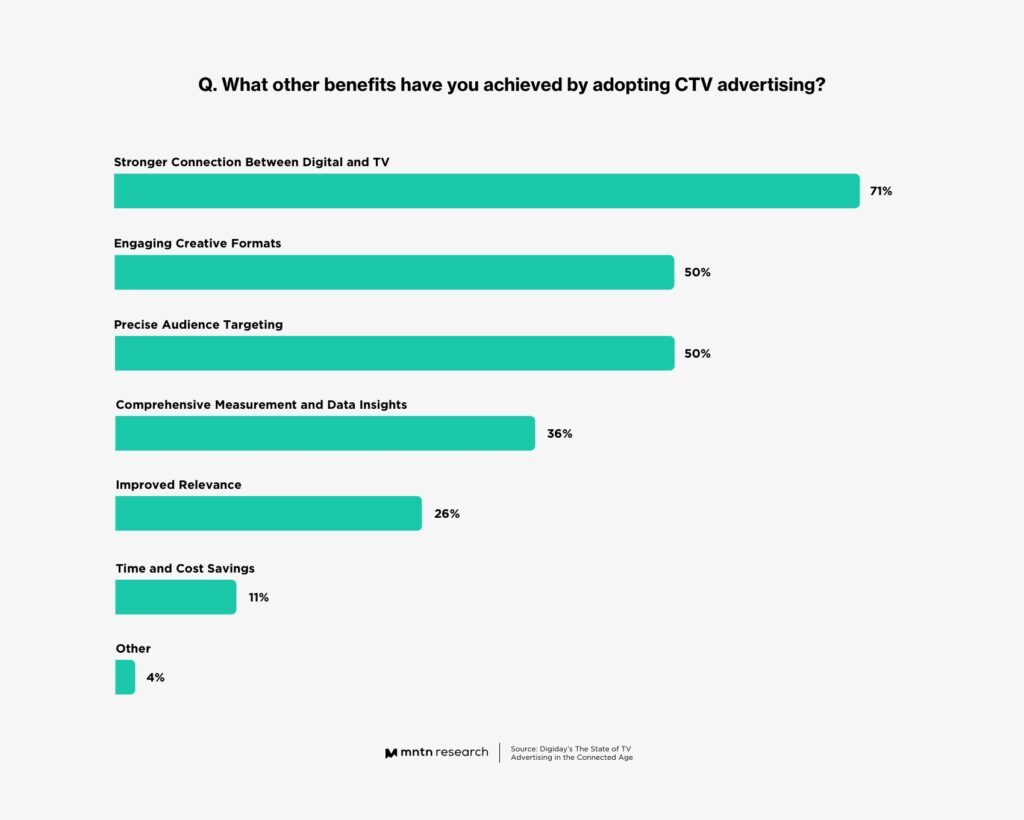
The key challenges when it comes to effectively measuring CTV performance aren’t significantly different from challenges experienced in other marketing channels. Mainly, CTV marketing teams deal with fragmented data and inventory while figuring out how to measure cross-channel performance and solve the attribution equation.
“Brands are assessing how they can advance their attribution model and view things holistically, recognizing that different channels have different places within the sales funnel. How do you account for that effectively?” said Tierney at MNTN. “The holy grail for CTV marketers is being on a platform that can give you a comprehensive view of every dollar you spend and match it to an attributable transaction,” said Christopher Contreras, senior vice president of customer success at MNTN. “We want to move Some of the critical challenges our respondents have encountered as they use CTV advertising include inventory fragmentation (53%), being able to reach relevant audiences (49%) and inconsistent measurement (42%).
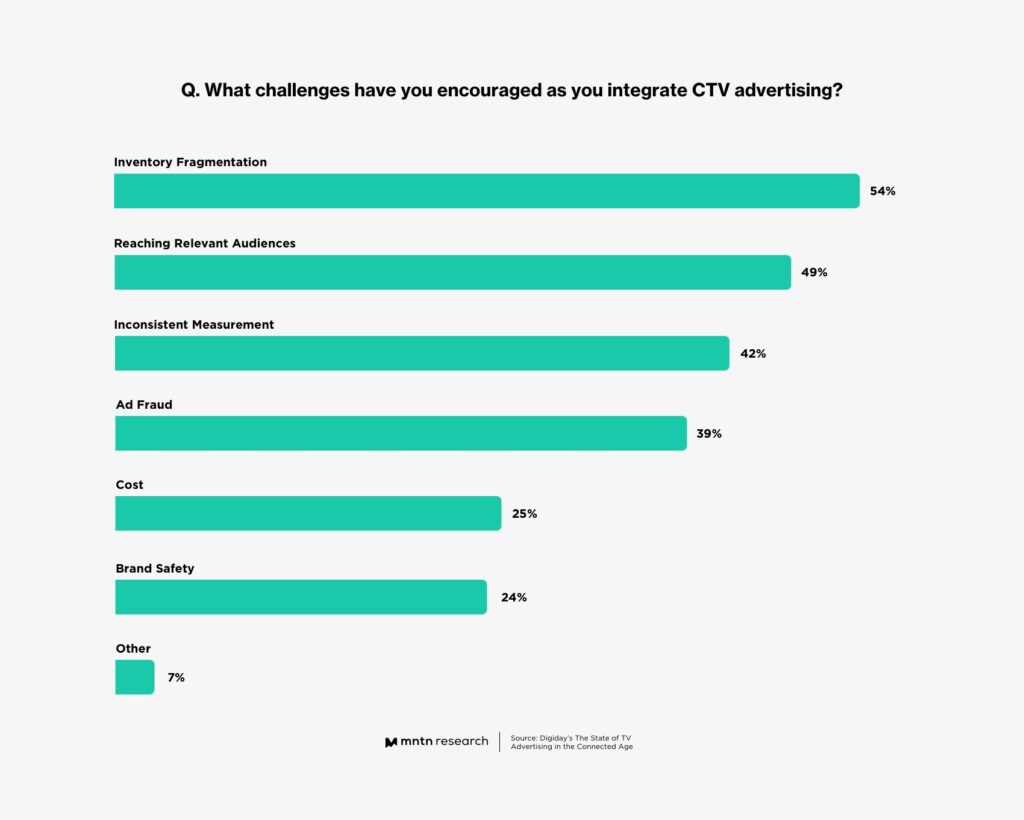
Still, with CTV data, there comes a degree of visibility that marketers could not achieve with traditional television. Brands and their partners can report on conversion order IDs so advertisers can match that back into their system to bridge the data gap.
“The holy grail for CTV marketers is being on a platform that can give you a comprehensive view of every dollar you spend and match it to an attributable transaction,” said Christopher Contreras, senior vice president of customer success at MNTN. “We want to move more toward database decisioning in a format that is impactful to customers and their experience in wanting to purchase a product.”
Next Steps: Building the Right CTV Team
To better measure CTV ad performance, 75% of respondents are partnering with third-party technology vendors for their expertise. More than half of respondents (57%) also take a hybrid approach using tech partners and in-house experts. As marketing teams seek out third-party technology partners to improve performance measurement, they are taking these steps to ensure their CTV investments pay off in the future:
- Work with a CTV technology partner that helps test and iterate. Marketing teams seek vendors that can facilitate testing, from numerous creatives for a single campaign to how to segment and target audience demographics.
- Align resources around creative development. Advertisers are working with tech partners to understand whether creative elements—new or repurposed—can translate to the CTV medium. Tech partners should efficiently assess what creative will and won’t garner results and offer support in piecing together the assets to produce an effective CTV spot.
- Be open-minded and patient with CTV performance. Experienced marketers understand that navigating CTV execution and measurement will be a learning experience. “For some brands, breaking into the CTV space might be their first time doing TV advertising at all,” said Contreras at MNTN. “Teams need to be aware that they’re moving into an environment that performs well, but it will take time to ideate and learn what works best for their brand.”
Conclusion
CTV presents a significant marketing opportunity for advertisers in 2022 and beyond. Taking the steps outlined in this blog to improve measurement and creativity within the medium will help teams achieve the marketing success they seek in the future.
Subscribe to the MNTN Research Weekly
Sign up to receive a weekly feed of curated research, sent straight to your inbox.
Resources
1 The State of TV Advertising in the Connected Age (Digiday)
2 'CTV Took From Everybody’: How Connected TV Won This Year’s Upfront (Digiday)
3 As Online Shopping Intensifies, E-Commerce Marketers Are Becoming Increasingly Reliant on Facebook’s Ads (Digiday)
4 WWDC 2021: Apple Calls Open Season on IP Address Tracking and Targeting (AdExchanger)
5 Business of TV Forum Recap: 2021 Will Be the Year of CTGV and Flexible and Transparent Video Media Buying (Digiday)
6 How CTV is Transforming, and Why Marketing Teams Are Following Suit (Digiday)